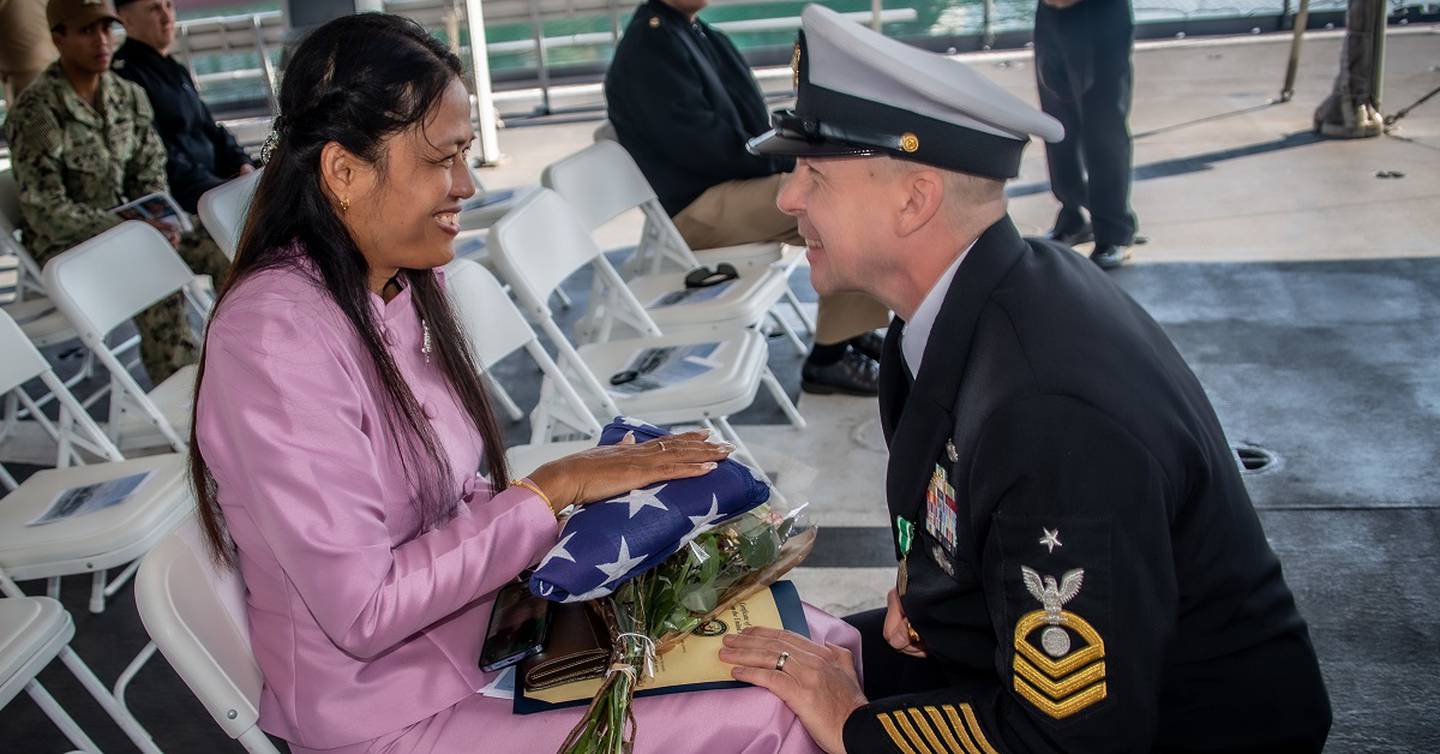Military service members and veterans have seen major changes to their pay and benefits over the past several years.
Basic pay has been rising, and service members saw a 4.6% increase in 2023, the highest annual increase since 2003. The Basic Allowance for Housing increased, on average, by a whopping 12.1%, and it ranged up to 38%.
The BAH increase reflects the skyrocketing costs of housing around the country. At the same time other increasing costs nationwide, including for health care, have affected military families in other ways.
Whether it’s health care, retirement benefits, commissaries and exchanges, family support, VA loans, GI bill education benefits or the plethora of other benefits, maximizing the options available to you is essential to making the most out of your military career. These are your benefits. Getting smart about the rewards you have earned is worth your time.
Basic Pay Housing Allowance Retirement Pay Tricare Changes Life Insurance Spouses and Children Buying a Home GI Bill and Tuition Commissaries and Exchanges
BASIC PAY ON THE RISE
Service members saw a significant pay increase in January, but the 2024 pay raise could be the largest in decades.
Basic pay is determined by rank and length of service, with automatic raises when troops meet certain time and promotion markers. In addition, each year Congress determines how much of a pay raise all troops should get.
The figure is tied by law to the anticipated increase in private sector pay, but lawmakers in the past have approved bigger raises to help with recruitment and retention or smaller raises to save money for other military priorities.
The annual military pay increase takes effect in January of each year. The White House issues its target for the hike each August, either going along with the projected rise in private sector wages, known as the Employment Cost Index, or offering justification for proposing a different rate.
Congress has the final say, however. In the past, lawmakers have overridden attempts by the White House to submit lower pay raises in an effort to save money for other priorities. The raise is usually applied across the board, although lawmakers made an exception at the height of the wars in Iraq and Afghanistan to provide more money for some mid-career service members to help with retention.
The most junior enlisted service members make around $25,000 a year in basic pay (not including allowances, special pays and other benefits), while enlisted troops nearing retirement typically earn about $70,000 annually.
Officer pay is significantly higher: The most junior officers clear close to $40,000 a year while senior officers nearing 20 years of service can make in excess of $170,000. That means that even a small change in the anticipated pay raise calculations can make a big difference for military families.
For example, in past years (not in 2022) the Pentagon has backed plans for a pay raise 0.5 percent below the federal formula for the annual increases.
If that reduction were put in place for 2023, an E-4 with three years of service would see a difference of about $160 in take-home pay over the course of a year compared to the expected level of pay boost. For a senior enlisted or junior officer, the difference is closer to $340 over 12 months.
Outside advocates have said even though those gaps won’t cover a mortgage payment, they are the difference between being able to afford a monthly co-pay for prescriptions or having to go without. That makes even small increases or trims a major issue in the military community.
Since the start of the all-volunteer military force in 1973, Congress has authorized a pay raise of at least 1 percent for troops every year, even during budget cycles where other civilian wages held steady. Since 2018, those increases have been 2.5 percent or more.
The 2023 and 2024 pay raises
Troops in 2023 received their biggest pay raise in two decades. The 4.6% increase was up significantly from the 2.7% raise they received in January 2022, and the highest annual increase since 2003.
The pay boost matched the federal formula based on the annual Employment Cost Index calculation and received criticism from some lawmakers for not being high enough, given inflation’s effect on the cost of many basic household goods like groceries and gas.
For junior enlisted troops, the raise meant about $1,300 more in take-home pay this year. For senior enlisted and junior officers, it was about $2,500 more. An O-4 with 12 years’ service will see about $4,500 more over this year over 2022 pay levels.
Discussions on the fiscal 2023 pay raise have not yet begun on Capitol Hill, but are expected to commence in early spring. The ECI formula calls for a 5.2 percent pay raise in 2024, even higher than this year’s raise.
If that figure is approved, it will be the largest pay boost for military members since 2002, when the figure was 6.9%.
Congress is expected to debate the pay raise level along with the rest of the defense budget in the spring and summer. Typically, the full budget plan is not approved until winter, even though the next fiscal year begins Oct. 1.
This year, Republicans overseeing the House Armed Services Committee plan to establish a special panel on quality of life issues to explore a host of issues surrounding service member pay and benefits. That group is expected to begin their work in early summer, but any proposals they draft won’t be put into effect until late 2024 at the earliest.

Basic Allowance for Housing Climbs Sharply
The Basic Allowance for Housing increased by an average of 12.1% in January 2023, the biggest hike in at least 15 years.
The largest percentage boost in the allowance was at Twentynine Palms Marine Corps Air Ground Combat Center, California, where troops received an average 38% increase compared to 2022 rates.
Generally, rates for BAH are adjusted once a year and take effect Jan. 1. But surging housing costs in recent years have led DoD to move more quickly to ease the financial burden for service members, authorizing a temporary BAH increase in dozens of housing areas in 2021 and 2022. The service members, eligible from Oct. 1 through Dec. 31 of those years, were required to apply for the extra money but it’s retroactive and they can still apply if they were eligible. The temporary increases ended when the new new annual rates took effect.
Meanwhile, there are ongoing reviews of how BAH is calculated and whether it meets the needs of service members.
What is BAH?
Basic Allowance for Housing provides service members not living on base or in government-provided housing a cash supplement to be able to rent housing at local market rates. The amount paid to a service member depends on rank, whether or not they have dependents, and where they are based.
This tax-free benefit is set at a level intended to cover 95 percent of the estimated average housing costs for each assigned duty post in the U.S. Individual service members are now expected to pay the remaining 5% of housing costs out of pocket.
Any active-duty service member stationed in the 50 U.S. states who is not provided with government-owned housing is eligible. Most service members have the choice of where to live. Those living in privatized housing — owned and operated by civilian companies for the military — generally pay their BAH to the housing company each month.
If a service member can find housing in the civilian community below the BAH rate for their assigned location, they are able to pocket the difference.
Those stationed in U.S. territories or overseas who are not provided government housing are eligible for an Overseas Housing Allowance, which is calculated under a separate formula.
Unlike BAH, however, the allowance only covers what they are actually spending on housing. They can’t pocket money they don’t spend.
How BAH is calculated
DoD conducts a survey to calculate median rental costs for 300 military housing areas, including Alaska and Hawaii. The calculations are based on the rental costs for a one- or two-bedroom apartment, a two- or three-bedroom townhome, and a two- or three-bedroom single family home. Junior enlisted, for example, might be entitled to a small apartment while more senior enlisted and officers might be entitled to a house.
Two rates — with and without dependents — are set for each location. The with-dependents rate goes to personnel with at least one dependent, whether that be a spouse or a child, and does not increase for additional family members.
BAH varies widely, based on rank, dependents and local real estate markets. For example, an E-1 without dependents at Twentynine Palms receives $1,569 a month. An O-4 with dependents stationed there gets $3,111. An O-6 with dependents stationed at Fort Sill, Oklahoma, gets $1,962 a month, according to DoD.
For details of locations across the country, you can use the Defense Department’s official BAH calculator.
Service members receive BAH rate protection as long as they remain in their home, even if rates drop. However, if they move, are demoted or their dependency status changes, they would receive the rate for their new status.
If rates rise in a location, all service members receive the higher rates regardless of when they arrived.
For dual-military couples with no children, both spouses get the without-dependents rate. If the couple has children, one spouse receives the with-dependent BAH rate, while the other gets the without dependents rate.
More information on BAH is available from DoD.

Basic Needs Allowance
A new Basic Needs Allowance for low-income military families took effect Jan. 1. The payout is designed to serve as a safety net for individuals whose total family income, including the spouse’s income, falls below 130% of the federal poverty guidelines, which are set annually. In 2023, a family of three with less than $46,600 in total income would be under that 130% mark. But for many members, the housing allowance puts them above the threshold.
Few service members were eligible for the assistance when the initial eligibility rules were released this year. Service officials have been screening service members and notifying those who might be eligible. As of Feb. 1, only about 85 individuals were potentially eligible, far fewer than outside advocates had expected.
Once service officials notify service members of eligibility, those individuals must apply for the new allowance.
Congress last year passed language in the annual defense policy bill raising the income eligibility for the allowance to 150% of federal poverty guidelines. Defense officials have until 2024 to implement that higher mark, but could do so earlier.
Researchers from Rand Corp. have said as many as 1,135 troops would qualify for the assistance under that higher benchmark. DoD policy allows service members who believe they may qualify for the benefit, but haven’t been screened as eligible, to submit applications on their own. They should contact their financial counselors for help in understanding the requirements.

Retirement Pay
All service members entering the military are automatically enrolled in the Blended Retirement System, or BRS. Only those with service prior to 2018 remain in the legacy, all-or-nothing 20-year pension plan.
BRS is a blend that combines traditional monthly retirement checks of the legacy system with some new features that allow military members to take some financial rewards with them even if they don’t serve up to the 20-year mark to qualify for a retirement pension. Historically, only 19% of active-duty service members and 14% of Guard and reserve members in the legacy system served long enough to get retirement benefits.
In 2018, more than 400,000 eligible service members opted into the new BRS, out of the 1.6 million serving active-duty and reserve troops who were eligible to make a choice between the legacy system and the new system.
Whether you opted in or are part of the new crop of service members automatically enrolled in BRS, you need to pay attention to the key elements of the BRS, because it’s a critical part of your retirement planning and financial future:
How the Blended Retirement System works
Under the BRS, you’ll get the traditional monthly retirement pay for life if you serve for 20 years or more and earn a full retirement from the military. But it’s 20% less than what it would have been under the legacy system.
If you retire from active duty with 20 years of service under BRS, you’ll receive 40% of the average of your highest 36 months of active-duty pay as your retirement pay. That percentage increases by 2 percentage points for each additional year of service. The legacy benefit provides 50% of your highest 36 months of pay.
Retirement pay has an annual cost-of-living adjustment.
Thrift Savings Plan
The Thrift Savings Plan, or TSP, is like a private-sector 401(k) retirement plan savings account. The TSP has been available to service members for years, but a government match has been added. The money you contribute to your TSP is always yours. You own the DoD contributions after you serve at least two years.
Here’s how it works: After you have served for 60 days, a TSP account will be created and automatic deductions of 3% of your basic pay start going to your TSP. (You can change that amount, but by law, you will automatically be reenrolled at 3% each year.) DoD kicks in 1% automatically, but will contribute up to an additional 4% of base pay to match your contributions.
So, if you put 5% of your base pay in your TSP, DoD also puts in 5%. Making your 5% contribution to your TSP is key to getting the maximum benefit out of BRS.
While service members should contribute at least 5% of their basic pay to get the full DoD match — and not leave money on the table — everyone can contribute more, up to a limit of $20,500 in 2023. For those with civilian retirement accounts such as a 401(k) as well as a TSP, the contribution limits apply to the combined amounts.
Continuation pay and retirement
The services will make a one-time payout of continuation pay when a service member reaches 12 years of service. To receive that continuation pay, which is similar to a retention bonus, you must commit to serve an additional four years.
In 2023, active-duty soldiers, sailors, airmen and guardians get 2.5 times their monthly basic pay as of the first day of their 12th year of service. Reserve and Guard members of these services get half their monthly pay — except for those in the Army Reserve and Guard, who get four times their monthly pay. For Marines, 2023 means a big bump: five times monthly basic pay for active duty and a full month’s pay for reservists.
It’s the prerogative of the services to adjust that multiplier to meet their retention needs. Continuation pay is taxable, but you can also contribute all or part of it to your TSP. You can receive it in a lump sum or, to help reduce your taxes, you can opt to receive continuation pay in four equal installments over four years.
Lump sum retirement pay option
When you retire under BRS, you can request an up-front lump-sum payment of part of the retirement pay you’d receive before you reach full Social Security retirement age, which for most people is age 67. You can receive either 25% or 50% of its “discounted present value.” That means the amount is cut by a discount rate published yearly. For 2023, it’s a 6.32% reduction.
If you take the lump sum, the retirement checks are reduced by either 25% or 50%, depending on which percentage you received, until you reach age 67. At that point, your retirement check returns to its full amount. The lump sum is taxable; retirees can choose to receive the money in up to four installments over four years to reduce the tax burden.
TIP: To get the most out of your BRS benefit, make sure you’re contributing at least 5% to your Thrift Savings Plan account, to get the matching DoD contribution of up to 5%. Why turn down free money?
You can find more information about BRS via the Defense Department.

Tricare
The Tricare health care program is one of the most important benefits for almost 9.6 million beneficiaries.
Some military families have seen a rise in their health care costs in 2023. Generally speaking, if a Tricare beneficiary paid out of pocket for Tricare before, those costs went up. active-duty service members don’t have any out-of-pocket costs.
Pharmacy costs will hold steady through the end of 2023, with no pharmacy copay increases. Active-duty members pay nothing for their covered medications through military pharmacies, retail pharmacies in the Tricare network and through the home delivery benefit. The military pharmacy is still the lowest cost option for all military beneficiaries, because there’s no cost for covered generic and brand-name drugs at these pharmacies.
There are fewer community pharmacies in the Tricare retail pharmacy network this year after more than 10,600 independent retail pharmacies chose to leave the network. More than 42,000 pharmacies remain in the network — including nearly 12,000 independent pharmacies — compared to more than 59,000 in 2022.
There is also a new Tricare Pharmacy Home Delivery policy: You must approve each refill when you’re enrolled in the automatic refill program, so that you only receive the prescriptions you need. Express Scripts, the administrator of the program, will let you know by phone, email or text, that you have a refill coming up. You’ll log in to your account to confirm you want it.
Tricare expanded the telehealth program during the pandemic to make it easier for military beneficiaries to get care. It now covers telehealth visits over the phone as a permanent benefit. While there was a temporary waiver on patient costs for telehealth during the pandemic, patients now pay cost-shares and co-pays. Telehealth costs are like costs for in-person care.
Tricare also covers the use of secure video conferencing to provide medically necessary services, allowing patients to connect with a provider using a computer or smartphone.
Who’s eligible?
Tricare offers 11 different options, with choices depending on the status of the military sponsor and the geographic location. It is open to active-duty members; military retirees; National Guard and reserve members; family members (spouses and children registered in the Defense Enrollment Eligibility Reporting System) and certain others, including some former military spouses and survivors, as well as Medal of Honor recipients and their immediate families.
Those entering the military or changing status (e.g., from active duty to retired) should make sure they and their eligible family members are enrolled in the Tricare program of their choice. Those who don’t enroll may only receive care at a military clinic or hospital on a space-available basis; medical care by civilian providers would not be covered. The one-month open season begins on the Monday of the second full week in November. During that time, you can enroll in a new Tricare Prime or Tricare Select plan or change your enrollment. If you’re satisfied with your current Tricare health plan you don’t have to take action.
The law overhauling Tricare included a strict limitation on switching plans outside of open season. The exception to that rule is if there is a qualifying life event, such as the birth of a baby, a move to a new duty station, marriage or retirement.
For retirees, a new dental program, the Federal Employees Dental and Vision Insurance Program, or FEDVIP, has replaced the now-defunct Tricare Retiree Dental Program.
What are the options?
Tricare offers two core options: Tricare Prime and Tricare Select.
All active-duty members are required to enroll in Tricare Prime; they pay nothing out of pocket. Active-duty families can also enroll in Tricare Prime without an enrollment fee. Prime beneficiaries are assigned a primary care manager, or PCM, at their local military treatment facility or, if one is not available, they can select a PCM within the Tricare Prime network. Specialty care is provided on referral by the PCM, either to specialists at a military facility or a civilian provider.
Tricare Select is similar to a traditional fee-for-service health plan. Patients can see any authorized provider they choose, but must pay a deductible and co-pays for visits. Patients pay lower out-of-pocket costs when they receive care from a provider within the Tricare network.
All Tricare programs have a cap on how much a family pays out of pocket each fiscal year, depending on the sponsor’s status and the type of Tricare program used.
By law, Tricare beneficiaries fall into one of two categories:
♦ Group A: Sponsors who entered the military before Jan. 1, 2018, and their dependents; and
♦ Group B: Sponsors who entered the military on or after Jan 1, 2018, and their dependents.
Those in Group A and Group B have different enrollment fees and out-of-pocket costs.
The plans
♦ Tricare Prime: Similar to a health maintenance organization, Tricare Prime has lower out-of-pocket costs but requires enrollees to use network providers and coordinate care through a primary care manager — a doctor, nurse practitioner or medical team. It’s free to active-duty members. Families enrolled in a Tricare Prime plan don’t have to pay enrollment fees or co-payments unless they use the point-of-service option or fill a prescription outside of a military pharmacy. Retirees must pay an annual enrollment fee (Group A retirees pay $351.96 for an individual, $703.92 for a family in 2023). Co-payments for medical visits are lower than other programs.
♦ Tricare Prime Remote: Service members who live and work more than 50 miles or an hour’s drive from the nearest military treatment facility must enroll in Tricare Prime Remote. Family members are eligible if they live with an enrolled service member in a qualifying location, or they may use Tricare Select.
♦ Tricare Prime Overseas: This is a managed-care option for active-duty members and their command-sponsored family members in nonremote locations. They have assigned primary care managers at a military treatment facility who provide most care and referrals for and coordination of specialty care. Tricare Prime Remote Overseas is a managed care option in designated remote overseas locations, with most care from an assigned primary care manager in the local provider network who provides referrals for specialty care. Activated National Guard and Reserve members and their families also may enroll in these options while the sponsor is on active duty; retirees and their families aren’t eligible.
♦ Tricare Select: This is a preferred provider plan — authorized doctors, hospitals and other providers are paid a Tricare-allowable charge for each service performed. Costs are higher for out-of-network providers, and certain procedures require pre-authorization. There is no enrollment fee for active-duty families. Group A working age retirees were required to start paying monthly enrollment fees in 2021. Co-pays vary by status and type of care: An in-network primary care outpatient visit costs Group A retirees and their families $34 in Tricare Select, for example, while Group A active-duty family members pay $25. Group B active-duty family members pay $18.
♦ Tricare Reserve Select: Qualified Selected Reserve members can buy Tricare coverage when they are in drilling status — not mobilized. The program offers coverage similar to Tricare Select.
♦ Tricare Retired Reserve: “Gray area” National Guard and Reserve retirees who have accumulated enough service to qualify for military retirement benefits but have not reached the age at which they can begin drawing those benefits (usually age 60) can purchase this insurance, which offers coverage similar to Tricare Select.
♦ Tricare for Life: This wraparound program is for retirees and family members who are eligible for Tricare and Medicare. The provider files the claims with Medicare; Medicare pays its portion and then sends the claim to the Tricare for Life claims processor. Enrollees must enroll in Medicare Part A (free for those who paid Medicare taxes while working) and Part B (monthly premium required) to receive Tricare for Life.
♦ Tricare Young Adult: Unmarried dependent children who do not have private health insurance through an employer may remain in Tricare until age 26 under a parent’s coverage via TYA Select or TYA Prime. Premiums are required for both.
♦ US Family Health Plan: Beneficiaries who live in one of six designated areas, can enroll in this as a Prime option. Those enrolled get all their care, including prescription drugs, from a primary care provider the beneficiary selects out of a network of private doctors affiliated with one of the not-for-profit health care systems in the plan. Beneficiaries don’t get care at military hospitals or clinics, or from Tricare network providers when enrolled in the US Family Health Plan.
Action items
Beneficiaries must take action to enroll in a Tricare plan in order to be covered for civilian health care. Those who don’t enroll will only be able to get health care at a military clinic or hospital on a space-available basis.
To be eligible for any of the Tricare plans, beneficiaries must first be enrolled in the Defense Enrollment Eligibility Reporting System. Active-duty members are automatically registered in DEERS when they join the military, but they must register eligible dependent family members. Service members should make sure the information is correct for their family members. Only military members can add or remove family members; this is done through the local ID card office.

Life Insurance
Service members automatically received an extra $100,000 of life insurance coverage starting March 1, increasing the maximum Servicemembers’ Group Life Insurance coverage amount to $500,000. All service members automatically got the extra coverage, including those who have previously declined or reduced their Servicemembers’ Group Life Insurance, known as SGLI. The boost applies to all those eligible for SGLI, including active duty, Guard and reserve members.
Troops pay a premium of $31 per month for $500,000 worth of coverage, which will be deducted from their pay. The extra $100,000 of coverage costs them an extra $6 per month. The rate hasn’t changed; the cost is still 6 cents per $1,000 of insurance. SGLI coverage is offered in increments of $50,000. The monthly premium is the same regardless of the service member’s age or other factors.
If active-duty service members want to decline or reduce their new coverage, they can use the SGLI Online Enrollment System. Reservists with part-time SGLI coverage who want to reduce or decline their coverage should use Form SGLV 8286 and provide it to their personnel office.
It’s the first time the maximum SGLI coverage amount has increased since 2005.
The maximum coverage for Veterans’ Group Life Insurance, or VGLI, also increased to $500,000, also up by $100,000. That is not automatic. Eligible veterans must request it. Service members leaving the military on or after March 1 who had the maximum SGLI coverage can purchase VGLI coverage up to $500,000. Veterans under age 60 who currently have $400,000 maximum VGLI coverage will be able to purchase additional coverage, in increments of $25,000, at specified anniversary dates.

GI BILL AND TUITION ASSISTANCE
In the past year, new restrictions were put on sailors looking to use tuition assistance and Congress passed new authorities to ensure GI Bill benefits aren’t disrupted by future national emergencies.
POST-9/11 GI BILL
The Post-9/11 GI Bill is a benefit for the latest generation of service members and veterans, as well as their eligible dependents. It includes payment of tuition and fees, a monthly housing allowance, and a stipend for textbooks and supplies.
The amount of time you spend on active duty determines your benefit level. In general, the higher your benefit level, the less you have to pay out of pocket for school, maxing out at the 100% benefit level, which covers full in-state tuition at public universities.
Here’s what veterans who received an honorable discharge after Sept. 10, 2011, are eligible for, based on the amount of time they’ve served:
- 100%: 36 months or more of active-duty service, or at least 30 continuous days and discharged due to service-connected disability
- 90%: At least 30 months, less than 36 months.
- 80%: At least 24 months, less than 30 months.
- 70%: At least 18 months, less than 24 months.
- 60%: At least 6 months, less than 18 months.
- 50%: At least 90 days, less than 6 months.
- No benefit: Less than 90 days.
If your service ended before Jan. 1, 2013, your Post-9/11 GI Bill benefits will expire 15 years after your last separation date from active service. If your service ended after that date, your benefit does not expire.
What it covers
You can use your benefits toward an education at a college, university, trade school, flight school or apprenticeship program.
While the benefit covers all in-state tuition and fees at public institutions, it may not have the same reach at a private or foreign school. The maximum tuition coverage for private nonprofit, private for-profit and foreign schools for the 2022-23 school year was $26,381.37. That figure is expected to increase again in August.
Housing stipend
The housing stipends GI Bill users receive depend on the level of benefits they’re eligible for, how many courses they take and where they go to class.
The rate is determined by DoD’s Basic Allowance for Housing scale and is paid at the same rate an active-duty E-5 with dependents would receive in a particular area. If you are pursuing a degree entirely online, you get half of the national BAH average.
Congress passed changes to the program at the start of the coronavirus pandemic to allow students forced online by campus closures and virus mitigation efforts to receive full housing benefits. Those protections have now expired, but could be used again in similar cases of national emergency under legislation passed by Congress in 2022.
The VA had historically based the housing allowance on the location of the main campus of a school, even if the student in question was taking classes at a different branch campus that could be many miles away. However, in 2019, the Forever GI Bill directed VA to instead base the housing allowance on the location where a student takes most of his or her classes.
Transfer rules
Service members may transfer their benefits to a dependent, provided they have already served in the military for at least six years and agree to serve four more after the transfer is approved by the DoD.
The transfer must happen while you are still in uniform. Veterans who have already separated from the military are not eligible to transfer their benefits. Children are only eligible to start using the transferred benefits after the service member doing the transfer has completed at least 10 years of service. Spouses can use the transferred benefits right away.
What’s new
♦ A pending court case could allow veterans who are eligible for both the Post-9/11 GI Bill and the Montgomery GI Bill to use both benefits consecutively, essentially giving some veterans another 12 months of education benefits. However, that issue is still under debate in the courts, and unlikely to be settled for the start of the 2023-2024 academic year.
♦ Active-duty troops who received a Purple Heart for combat injuries are now allowed to transfer their benefits to dependents regardless of how long they served or their ability to commit to more service.
♦ Since August 2022, active-duty servicemembers are eligible for the VA Yellow Ribbon program, which allows private schools to match VA benefits with their own tuition assistance.
More online
You can find more detailed info about the GI Bill here:
The VA also maintains a GI Bill Comparison Tool.
You can apply for the Post-9/11 GI Bill online or by visiting a local VA regional office. If you’ve already chosen a school or program, arrange a meeting with the institution’s VA certifying official, who can help you get started.
TUITION ASSISTANCE
Service members have more education benefits available to them than just the GI Bill.
While service members can begin to use their GI Bill benefits on active duty, they can often get help paying for college from their service branches — and save the GI Bill for later — by using tuition assistance.
TA is a federal benefit that covers the cost of tuition, up to particular limits, for active-duty service members, as well as some members of the National Guard and reserves. The funds are paid directly to schools by the service branches.
Each service has its own requirements.
♦ Air Force: All officers incur a service requirement if they use TA, but there is no service-length requirement to begin using the benefit. Enlisted airmen using tuition assistance must have enough time remaining in service to complete any courses in which they enroll.
♦ Navy: Enlisted sailors and officers, including Navy Reservists, must have a minimum of three years of military service before becoming eligible to use TA. That total was increased in 2022 from the previous requirement of two years service.
♦ Army: As of Aug. 5, 2018, there is no longer a one-year waiting period after completion of Advanced Individual Training, Basic Officer Leader Course or Warrant Officer Basic Course to receive TA. Active-duty officers incur a two-year service obligation.
♦ Marine Corps: After previously having to wait 18 to 24 months to use TA, Marines now have no minimum service-length requirements for the benefit. However, they must agree to at least two more years of active-duty service to use the benefit.
♦ Coast Guard: Active-duty members must have been on long-term active-duty orders for more than 180 days to access TA. The Coast Guard also has unit-specific requirements and requires commanding officer approval.
♦ Guard/Reserve: Soldiers who are activated or on drill status are eligible under the same conditions as active-duty Army personnel. Air National Guardsmen and reservists of other branches are eligible for TA if they are activated, and the use of TA often comes with a service obligation once the last course is completed.
Limits
The Defense Department caps tuition assistance at $250 per semester hour and $4,500 per fiscal year. The Coast Guard cap for fiscal 2022 totaled only $3,750, but it was increased to $4,500 for fiscal 2023.
Generally, TA funds can be used to pursue a higher degree than what you have already earned, up to the master’s degree level. If you have a bachelor’s degree, you can use it to pursue a graduate degree — not an associate or second bachelor’s, though there are some exceptions. Some branches require you to create a degree plan or take a branch-specific course before your TA benefits are approved.

Spouse and family support
For decades, military families have dealt with issues that come with the military lifestyle, such as frequent moves and deployments. They have many of the same needs as their civilian counterparts, but often have more difficulty finding employment and affordable, quality child care, for example.
Bases worldwide offer families a wide variety of support services, from legal assistance and tax preparation, to child care, education and employment assistance, financial counseling, relocation assistance, youth programs, and deployment and mobilization support.
To find out more about what’s available, start with the family centers on military installations or MilitaryOneSource.mil, which offers access to additional assistance by phone or chat, 24 hours a day.
Most of the information on Military OneSource is available to the public, but some extra services are available for free to service members and their immediate family members, survivors of deceased service members, and certain others. Retiring or separating service members and their immediate family members can also access these services for one year after they leave the service.
Among those services are nonmedical counseling — available in person, by phone, secure chat or secure video session — as well as financial counseling, including tax preparation and tax filing help. Spouse employment and education services; language translation services for documents, health and wellness coaching, child/youth behavioral counseling, and family life counseling are also available.
SPOUSE EMPLOYMENT AND EDUCATION
Spouses can visit their installation’s family center for employment and education assistance. They can also visit the Spouse Education and Career Opportunities, or SECO, section at MilitaryOneSource.mil for information about scholarships and other education and employment needs. SECO offers a free, personalized benefit through certified career counselors to help spouses investigate career options, education options or entrepreneurial projects.
Through DoD’s My Career Advancement Account program, or MyCAA, spouses of certain junior service members can receive tuition assistance of up to $4,000, with an annual cap of $2,000, to pursue licenses, certifications or associate degrees needed for employment in any career field or occupation. Spouses may also use their MyCAA scholarship at an approved institution to help with the costs of national tests for course credits required for a degree approved under the MyCAA program. This benefit is available to spouses of active-duty members in paygrades E-1 to E-5, W-1 and W-2, and O-1 and O-2. Under a recent provision in law, military spouses remain eligible for this financial assistance if their military sponsor is promoted beyond the eligible ranks, as long as they have an approved education and training plan in place through the program.
Spouses can also search job opportunities on the Military Spouse Employment Partnership site, where hundreds of businesses that have been vetted by the Defense Department are seeking to hire military spouses.
More than 600 employers are MSEP partners, and as the number has grown over the past decade, those employers have hired over more than 250,000 military spouses. The pandemic has shown the value of remote work in many professions, and remote work can be extremely beneficial for military spouses as they move from place to place. A number of these employers have remote work opportunities. In addition, through Military OneSource, spouses can get a free one-year membership to FlexJobs, a career platform that specializes in vetted, flexible and remote job openings.
Many military spouses spend time and money getting new professional licenses when they move to a new state. It costs money for exams and other fees, as well as lost pay potential as they go through the process. To help with these costs, the law allows spouses to apply to their service branch for reimbursement up to $1,000, for relicensing and recertification costs each time they relocate with their service member.
The Department of Labor has information about state professional licensing requirements, specifically for military spouses, at dol.gov/agencies/vets/veterans/military-spouses/license-recognition. It’s a resource to help military spouses understand the laws of each state, and to find information about the appropriate licensing board in the states for each occupation.
What’s new
A new federal law requires states to provide reciprocity of professional licenses, except for attorneys, to military spouses, but few details are available about how states will implement that law, the Military Spouse Licensing Relief Act, part of the Veterans Auto and Education Improvement Act of 2022.
A new paid fellowship program allows spouses to be placed with civilian companies seeking full-time employees. The Military Spouse Career Accelerator Pilot program is free to employers, and spouses will be paid by DoD during their 12-week fellowships. It’s open to spouses of currently serving members of the Army, Navy, Marine Corps, Air Force and Space Force, to include active, Reserve and National Guard components. The hope is at the end of the 12-week fellowship, the company will directly hire the spouses. There’s no guarantee, but this fellowship gives spouses the chance to show their skills and learn new ones.
Spouses interested in applying can visit the Military OneSource Spouse Education and Career Opportunities page at myseco.militaryonesource.mil/portal/article/military-spouse-career-accelerator-pilot.
Companies interested in hosting a military spouse fellow can learn more and sign up on the Hiring Our Heroes website, hiringourheroes.org/employers/hosting-a-fellow/mscap-host-interest-form/. The fellowship program is being administered through the U.S. Chamber of Commerce Foundation.
CHILD CARE
The Defense Department’s child care systems include more than 600 child development centers, school-age care facilities and a number of family child care homes at more than 230 locations worldwide. All are required to adhere to DoD regulations. These programs are nationally recognized for their quality, and programs meet strict standards for curriculum, safety and health. Fees are on a sliding scale based on total family income. Families can learn more about the child care options offered at or near their installation at the official DoD website MilitaryChildCare.com. The website gives parents more visibility over what child care slots are available at multiple installations in a given area, and allows them to register and apply for child care in advance. Families can submit unlimited requests for child care, and remain on waitlists for a preferred program even after being offered care by another program.
Working military families get higher priority in child care programs under a DoD policy implemented recently. The policy also allows officials to displace children who are already in a child development program if their parents are in a lower priority category and the gaining family is expected to be on a wait list for more than 45 days after the time they need care.
Any family child care provider on an installation who offers child care for other families’ children for 10 or more hours per week must be certified through installation officials. Families can get lists of certified family child care homes at their installation’s child development program office. They can also find certified family day care homes through the MilitaryChildCare.com website.
Military families can also find high-quality, subsidized child care in their local civilian community if care is not available on base. Families must register at the MilitaryChildCare.com website for fee assistance through this program, operated through the nonprofit Child Care Aware of America.
Military families also have another option to help them find hourly and on-demand child care. Through MilitaryOneSource, families will get a paid subscription to a service that lets them search for child care providers in the nationally recognized service. DoD doesn’t pay for the child care, but pays for the subscription to the service that provides connections to available child care providers.
What’s new
In the fiscal 2023 national defense policy legislation, Congress authorized funding for 16 more child development centers to help address the shortage of care. This was 14 more centers than the administration requested. It generally takes about five years before construction is completed and these centers open their doors.
DoD and the services are looking at new ways to ease the child care shortage, such as streamlining the hiring process for child care workers and providing workers higher pay and more benefits.
Congress has also approved a DoD pilot program that provides fee assistance for in-home child care. It’s currently available in 11 regions, with limited spaces available. MilitaryChildCare.com provides more information.

VA Home Loans
The Department of Veterans Affairs home loan program took shape near the end of World War II and has been used by millions of service members and veterans since then. It’s one of the most popular benefits for veterans. Lenders issued 746,091 VA-backed loans in 2022, with an average loan amount of $343,895. The total loan amount was nearly $257 billion.
The basics
The VA doesn’t issue the loans, it backs the loans issued by financial institutions. The VA guarantees a percentage of an eligible beneficiaries’ home-purchase or home-refinance loan, allowing the lender to provide better, more affordable terms and often letting the borrower seal the deal without a big cash down payment.
Eligible service members and veterans can apply, via private-sector lenders, for home-purchase loans. There are no VA loan limits for veterans who have the full entitlement. For a VA-backed home loan, you’ll still need to meet your lender’s credit and income loan requirements in order to receive financing. These VA home purchase loans can be used to buy manufactured homes or homes under construction, in some cases, but not mobile homes.
The VA loan program also offers cash-out refinance loans.
An Interest Rate Reduction Refinance Loan can reduce the rate on an existing VA-backed loan.
Fees
VA loans come with funding fees that vary by loan type and veteran status. Veterans using the benefit for the first time on a no-down-payment purchase loan pay a 2.3% fee, for example, while a veteran making a second cash-out refinance loan would pay a 3.6% fee. A full fee table is available via the VA.
Veterans receiving VA disability compensation are exempt from fees. Other loans, including joint loans, construction loans and loans to cover costs of energy-efficient repairs, also can be backed by VA. Consult your lender for information.
Action items
The key step for service members and veterans is to obtain a Certificate of Eligibility, either through the eBenefits site or via their lender, to be eligible for a VA-backed loan.
Those seeking to refinance existing loans should read lenders’ advertising material carefully: VA and the Consumer Financial Protection Bureau have warned against deceptive lending practices. Among the red flags are aggressive sales tactics, low interest rates with unspecified terms, and promises that borrowers can skip a mortgage payment as part of the new loan — a practice prohibited by VA.
Deadline
VA loan eligibility does not expire, though the entitlement can only be used for the borrower’s place of residence (not a rental property). It can be reinstated after the loan is paid off or under other circumstances — another veteran can assume the loan, for instance. Learn more from the VA.
Service members whose time in uniform falls within these date ranges must have 90 days of active-duty service to qualify:
- Sept. 16, 1940-July 25, 1947
- June 27, 1950-Jan. 31, 1955
- Aug. 5, 1964-May 7, 1975 (Note: For those who served in Vietnam, this era begins Feb. 28, 1961).
- For loan purposes, VA considers “Gulf War” service beginning Aug. 2, 1990, and continuing through the present day. Service members from that time period must have completed 24 months of continuous active-duty service to be eligible, or at least 90 days if they have the right discharge status.
- If your time in uniform doesn’t apply to the date ranges above and you were enlisted and separated on or before Sept. 7, 1980, or if you were an officer and separated on or before Oct. 16, 1981, you need 181 continuous active-duty days to qualify. If your service came after the above date ranges, you need 24 months of time in or less if you have certain discharges.
- Troops now on active duty become eligible after 90 days of service for as long as they remain on active duty. Eligibility now includes National Guard members with at least 90 days of active service including at least 30 consecutive days under Title 32, Sections 316, 502, 503, 504 or 505.
- Troops discharged for a service-connected disability are eligible regardless of service length.
What’s new
Eligibility has been expanded for National Guard members. It now includes troops with at least 90 days of active servicem including at least 30 consecutive days under Title 32, Sections 316, 502, 503, 504 or 505.
Some veterans have experienced difficulty in using their VA loan benefit, especially in competitive housing markets in which multiple bids are made on houses. VA officials have said that misperceptions still persist among sellers and agents that VA financing is less desirable than conventional loans. Those in the industry have recommended that veterans question their Realtors and lenders about their experiences and how often they’ve helped veterans use their VA loan benefit.
For more eligibility details, visit VA’s eBenefits site or call 877-827-3702.

MILITARY STORES
At a time when costs are rising on virtually everything, two benefits that help those in the military community stretch their dollars are commissaries and exchanges.
Commissaries are on-base stores that sell discounted groceries to authorized customers.
Exchanges are on-base stores (with an online component) that sell a variety of items ranging from clothing and shoes to toys, furniture, home appliances and electronics. They have on-base gas stations and stores that sell alcoholic beverages.
Over the past few years, eligibility to shop at military commissaries and exchanges has expanded to include more people in the military community.
COMMISSARIES
Those eligible to use the commissary benefit include active duty, Guard and reserve members, military retirees, Medal of Honor recipients, and their authorized family members. These shoppers have IDs issued by DoD. In a recent change, commissary employees can also shop, but not their family members. DoD and Coast Guard civilian employees in the U.S. and on service agreements overseas are among the authorized shoppers, too.
In 2020, eligibility was expanded to veterans with service-connected disabilities, Purple Heart recipients, former prisoners of war, and primary family caregivers of eligible veterans enrolled under the VA’s Program of Comprehensive Assistance for Family Caregivers. Eligible veterans use their veterans health ID card, or VHIC, to gain access to the installation and to shop. Spouses and other family members aren’t allowed to shop; however, they are allowed to come into the stores with the veteran. Family caregivers who qualify for the benefit will have access to a memo at VA.gov which will be used for entry, along with a driver’s license, passport or other authorized form of ID.
What’s new
In an effort to help service members and families deal with rising food costs, the Defense Department has invested in commissaries this year to decrease the price of most grocery items by about 3% to 5%. They’re particularly focusing on food staples like bread, milk, eggs and other items. Officials aim to increase overall commissary savings to 25%, compared to stores outside the gate. Before the extra funding, the overall savings were an average of 22%. Customers also pay a 5% surcharge which is used to cover construction costs and other needs.
The commissary agency finished rolling out its Click2Go program to all commissaries worldwide in the fall of 2021. Customers choose their items online, select a pickup time, and at the appointed time, head to the Click2Go parking spaces where commissary employees bring their groceries to their car and finish the transaction.
Commissary officials have been testing doorstep delivery at eight locations in the continental U.S. where authorized shoppers who live within 20 miles can order groceries to be delivered. For now, the delivery fee in most cases is less than $4. That’s in addition to tips customers might provide for the delivery driver. Contractors have focused on hiring military spouses. As of this writing, the future of the doorstep delivery isn’t clear, although commissary officials have said they’re working to expand the program and offer it at more locations.
Officials have taken other steps to boost the benefit, such as expanding hours of operation. That includes 56 stores that have converted from six- to seven-day operations.
Payment accepted: Cash, personal checks, travelers checks, money orders, debit cards, Military Star card, American Express, MasterCard, Visa, Temporary Assistance to Needy Families (TANF), Supplemental Nutrition Assistance Program, Women, Infants and Children (WIC), American Red Cross Disbursing Orders, commissary gift cards, and coupons.
Sales restrictions: Most commissaries don’t sell beer or wine, although there’s a limited test selling the libations in 12 stores. Commissaries do sell tobacco in stores on Army and Air Force bases. DoD policy is that tobacco can’t be sold at a discount greater than 5 percent below the lowest competitor in the local area.
Rules on who can use overseas commissaries are affected by status-of-forces agreements between host nations and the U.S. Situations vary by country, and individuals should check with the local U.S. military command or installation they plan to visit before they travel.
Most commissaries have evening and weekend hours. To find a store, and get information such as hours and directions, go the commissary website click on “Store Locator.”
EXCHANGES
Exchanges are the military’s version of department stores, selling discounted brand-name goods from civilian companies, as well as their own private label items. There is no sales tax.
There are four exchange systems: The Navy Exchange Service Command, the Marine Corps Exchange system; Coast Guard Exchange system; and Army and Air Force Exchange Service, also known as The Exchange. Eligible exchange shoppers can shop online at www.shopmyexchange.com, www.mynavyexchange.com and www.shopcgx.com.
Stores support themselves almost completely through their sales income. All profits are used to fund military Morale, Welfare and Recreation programs, and to build or renovate stores.
Eligible shoppers include all ranks of active duty, retired, National Guard and reserve members and their families, Medal of Honor recipients, and their families, surviving spouses and former spouses. Those eligible can shop at any exchange, regardless of service affiliation.
In 2021, defense officials expanded U.S. exchange shopping eligibility to DoD and Coast Guard civilians.
In 2020, the exchange benefit was authorized by law for all veterans with VA service-connected disability ratings; Purple Heart recipients; veterans who are former prisoners of war; and primary family caregivers of eligible veterans under the VA caregiver program.
All honorably discharged veterans can shop online at the exchanges. The Veterans Online Shopping Benefit does not grant on-installation access, unless the veteran falls into another category, such as having a VA service-connected disability rating.
Overseas stores offer many U.S. products that may be difficult to find otherwise. Commands often impose shopping restrictions to limit the sale of U.S. goods on the illegal market.
Stateside and overseas exchanges accept MasterCard, Visa, American Express and Discover credit cards. Exchanges also offer their own credit plan through the joint-exchange Military STAR Card.







